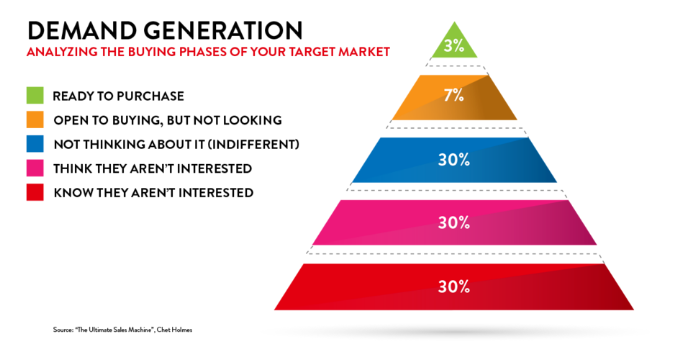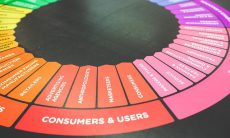In the Ultimate Sales Machine: Turbocharge Your Business, Chet Holmes mentions that only 3% of your target market is ready to buy, 7% of your target market is open to buying but not looking, 30% of your market is comfortable with the status quo and 30% of your market believes they aren’t interested.
When it comes to LinkedIn marketing and social selling, where do you think everyone’s focus is? It’s on the top 3% of the market meaning they’re missing out on 67% more opportunities that my clients (like Schneider) are getting with a 40% to 70% improved chance of closing.
How sales, marketing professionals, and social media lead generation companies are focused on only 3% of the target market
In a recent article, SAP‘s Nicholas Kontopoulos mentioned that social selling has become another form of spam. He wrote:
Social media is now just amplifying the bad selling behaviors of salespeople. Where a bad salesperson could deter dozens of potential customers, social platforms allow the same person to reach thousands of people…with the same one-night stand, transactional mentality and message.
LinkedIn marketing and social selling has become a volume play. The focus is on how many connections are being made, how many prospects are joining the LinkedIn community, how many views the content is generating, how much website traffic are they getting, how many people are being reached with messages. They’re focused on how many people are being added to the pipeline even if they aren’t validated and qualified. They’re focused on lead generation even though most leads go nowhere—when the focus should be on prospect development.
Even social media experts are talking about social media being a volume play
Jay Baer has mentioned in his talks that social media is a volume play. You have social media and social selling experts including Jeff Molander, John Nemo, and Brynne Tillman coaching clients and followers to use a template approach that lacks relevance to try to book as many calls and sales conversations as you possibly can. For example, Jeff Molander, a digital sales prospecting trainer and coach, teaches clients to use templates like:
Hi, Sam.
How are you adding new capability to your ______________ [insert area of business your product addresses] at any time soon or in future? I work with organizations like _______ [prospect’s business] to make sure ________ [goal]. Would you like to quickly explore, via email, if a larger conversation makes sense? Please let me know what you decide.
This is an account-based marketing approach that focuses on issues that are relevant to targeted organizations, key decision-makers, and influencers. Sales, marketing, and social media lead generation firms using this approach are hoping that if they send it out to enough people, it will be relevant to someone and stick. They are focused on “trying” to hit that 3% of the market—the people that are most likely ready to buy now. If those leads that may or may not be part of the 3% of the market do not move forward, then you have a high cost for business growth. And your efforts on LinkedIn are nothing more than a cost center. It doesn’t matter how low your cost-per-lead is if leads are being stuck at the top-of-the-funnel. It’s still a cost and investment that isn’t leading to revenue!
Social media firm focuses on lead goals even though the leads they delivered went nowhere
As I share in this cost-per-lead post, I recently spoke to the President and CMO of a logistics company. They were both so focused on how many leads we are able to deliver on a weekly and monthly basis. They proceeded to tell me how another social media lead generation firm was delivering 5 to 10 leads for sales calls per week.
However, those sales leads they were delivering sucked! 90% of the calls were with prospects who were not in the right stage of the buying process at this time—or they were with people who were not even decision-makers or influencers. The people who said “yes” to a call were just looking for free information, to network, and maybe refer the company. What good were those leads if no relationships were being created and leveraged to create revenue opportunities?
How sales and marketing can capture 67% more opportunities instead of just leads that go nowhere
- Focus on relevance across all levels using an account-based sales and marketing approach
Adding the person’s name or position to a message or talking about their industry does not make you relevant. When you’re engaging in prospect development, you’re not just relevant on one or two levels; you’re relevant to the industry, to the company, to the person’s role, and to the individual decision-maker or influencer.
Being relevant to each key decision-maker and opening doors with different demand units are what account-based sales and marketing is about. It’s how you can forge stronger connections within individual people within potential customer organizations. Remember, developing relationships require getting to know the potential customer and demonstrating how you can bring relevant value to them. This is how you’ll move those that are indifferent or think they are not interested in your solution.
- Engage in marketing for sales alignment
Marketers who go beyond lead generation and focus on Sales and Marketing alignment to achieve revenue goals using LinkedIn can prove a clearer, stronger social media ROI. By providing rich insights into buyers, their companies, and their territories, marketers enable sales to better prioritize their efforts. And by focusing on relationships and how to leverage them, marketers can become the social bridge between buyers and sales. They can help build familiarity between salespeople and their customers. Together, sales and marketing can improve sales effectiveness using LinkedIn.
But marketing has to use its influence on LinkedIn, become more of a sales enabler, and support sales in a more meaningful way so they can close deals. There can’t be these silos anymore where marketing is focused on the company page, sponsored updates and the solutions that LinkedIn Marketing Solutions provides and relying on sales to make the relationships. Marketing needs to become a sales enabler on LinkedIn. This is best achieved with the complete awareness to revenue customer life-cycle that includes a set of psychological transitions where customers become aware of, evaluate, like, advocate, and invest in a specific product or service. We need to go beyond the awareness tactics that social media and digital marketing executives take and meld traditional marketing with LinkedIn to increase the percentages of transitions, as well as increase the speed at which they transition.
- Focus on breaking down the potential customer’s status quo
When going beyond the 3% of the market that is ready to buy, you have to spend time breaking down the customer’s status quo. As the CEB mentions in their Challenger Demand Generation Marketer Role Guide:
Without breaking down the status quo, potential customers may engage with your content, talk to your sales reps, and nod along. But ultimately. they won’t take the hard actions to drive consensus and take the next steps toward investing in your solution.
It’s not enough to just challenge prospects and show them a new approach. You need to give prospects a reason to change. For a positioning and messaging firm client, we were only able to help the firm gain clients once the firm’s President was able to show sales and marketing how their positioning and messaging was affecting sales and marketing performance–especially in the areas that were high on the priority list. Once we were able to target specific companies with specific positioning and messaging issues, and show sales and marketing leaders why they needed to change, the firm gained clients like Membrain, Mariner Partners, Shift Energy, Idea5, Rocket Software, and SmartOrg.
- Don’t optimize content for social media engagement
When you’re optimizing content for social media engagement, you’re optimizing it for reach. You’re optimizing the content for top of the funnel awareness which may attract that top 3% of the market that is ready to buy but it won’t move the other 67% of the market. As the CEB mentions, you want to optimize your content for consumption of disruption or, in other words, focus on how your content is driving changes in thoughts and actions.
- Focus on lead validation and qualification
The Chief Learning Officer at PeopleLinx, CEO of Social Selling LinkedIn, and Co-Founder of Business Development University and Social Sales GPS tells clients:
With each new connection, determine if they are someone you’d like to speak with and tweak the LinkedIn message slightly: NAME, it is nice to be connected on LinkedIn. Typically I like to have a brief call with my new connections so we can explore ways we might be able to work together now or in the future. Here is a link to my calendar: xxxxxxxx. Please pick a time that is most convenient for you. I am looking forward to our call.
She’s telling business leaders and sales and marketing professionals to go for the call; don’t worry about lead qualification and validation. Don’t worry if they haven’t seen your value yet and that you haven’t demonstrated your relevance. Don’t worry if you haven’t identified a need yet and don’t worry if they are not in the right buying stage. This shotgun thinking assumes that getting the sales information “out there” may eventually lead to a sale. But all it really does is cost you time and money.
Inside my Get Help with Linked Strategies Group, we’re showing how to apply account-based marketing and the challenger sale to the LinkedIn marketing and social selling environment. We’re discussing how to go beyond the top 3% of the market to get 67% real sales opportunities—not leads, but actual sales opportunities that move forward.
Click here to join the Get Help with Linked Strategies Group







Thanks for the useful information.
I have tried Meet Alfred It provided me alot of leads in 1 month.
You should also try and see the amazing results.